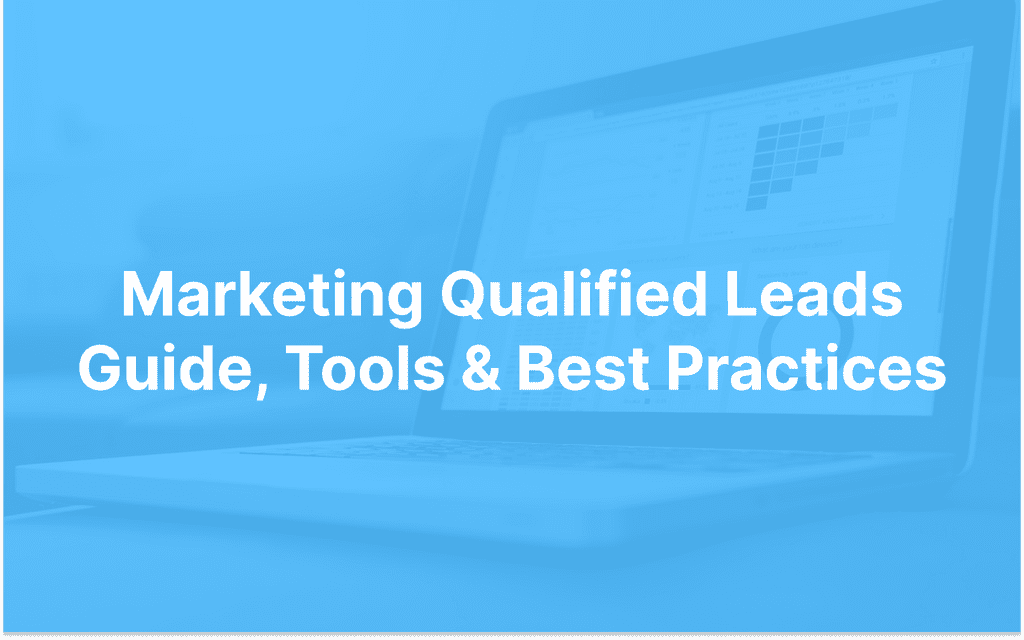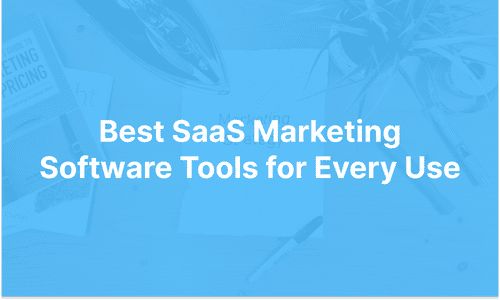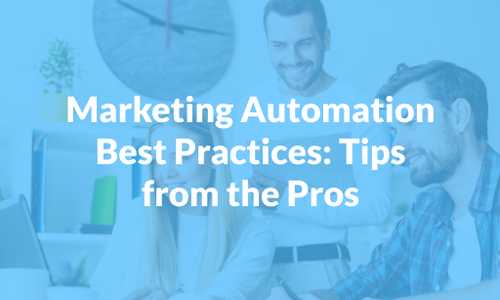Do you want to generate more marketing-qualified leads? Of course you do. Jumping from a lead to a marketing qualified lead (MQL) naturally means a significant boost in conversions for your SaaS business. MQLs bridge the gap between regular leads and sales-qualified leads (SQLs).
Interestingly, APSIS states that 80% of marketers claim automating their marketing processes increases their leads by 451%. More still, 77% of these marketers enjoy more conversions than those who don’t take advantage of automation software.
Customerly is all about automated marketing. We can put your marketing efforts, like emailing your leads and onboarding your customers, on autopilot. Use Customerly to build automated marketing funnels that integrate perfectly with your customers’ journeys and ultimately boost your MQLs.
If you want to learn more about how to qualify marketing leads, read on. This guide will walk you through the steps you need to take to guide more leads further through the sales funnel to become MQLs.
What are Marketing Qualified Leads?
A marketing-qualified lead is a lead that’s expressed interest in your brand, products, or business by engaging with you. This could be through signing up to a newsletter or downloading a free ebook.
At the MQL stage, a lead is not quite ready to make a purchase. However, with some nurturing, you can boost your MQLs to SQLs so they’re in a more comfortable position to buy. For instance, here’s Hubspot double opt-in confirmation email subscribers receive upon registration.
Here are some more examples of marketing qualified leads:
- Using software demos.
- Engaging with your brand on social media with likes, comments, etc.
- Visiting your website often.
- Clicking on your ads.
- Filling in an online form to request more information.

Why is Identifying Marketing Qualified Leads Important?
1. Enhances Marketing Strategy
Marketers can use marketing-qualified leads to enhance their marketing strategies. Studies suggest that just 10-15% of leads make it all the way through to the bottom of the sales funnel. This dismally low number can be boosted with effective customer targeting. When your leads convert to marketing-qualified leads, you can use that data to identify what marketing tactics are most likely to lead to different conversions.
For example, you might find that particular landing pages generate more MQLs than others. In this case, you would direct more leads to that landing page.
2. Improved Lead Quality
When your leads turn into MQLs, they’re higher quality leads that are more likely to be interested in what you’re offering. Equally, you’ll have more information about each lead to build your buyer persona.
Marketing qualified leads can allow you to tailor your content to different potential customers. You can hone in on the most promising demographics, customer interests, and marketing channels and tailor your content to appeal to specific audiences.
3. Better ROI
MQLs deliver a better ROI than regular leads because they’re more likely to make a purchase when they read an ad, marketing email, or social media post promoting your SaaS products. As MQLs are further down the sales funnel, it takes less effort, and money, to convince them to convert.
There’s actually a psychological reason for this. The Foot in the Door technique is well-known in the worlds of both psychology and sales. It works on the principle that when someone agrees to do something small, such as handing over their email address or subscribing to a blog, they’re more likely to go on to complete a bigger, more important task for that person or company, such as making a purchase.
MQLs work on this basis too, and the increased likelihood of them buying from you means you won’t need to spend as much money advertising to MQLs as you would regular leads.
How to Qualify Marketing Leads
Create a List of Criteria
To qualify a marketing lead, you need to establish criteria that turn an ordinary lead into a MQL. Even those who’ve shown interest in your brand are not necessarily MQLs. For example, the lead may simply be interested in reading your newsletter but have no intention of signing up for your SaaS.
To determine your MQLs, consider listing the following criteria:
- Budget: The lead must be able to afford your product or service. Leads who window shop for things they can’t afford don’t generate sales. Google Ads can help here, as you can qualify leads based on income. Other than that, you might consider a lead’s job, along with their level of education, to determine whether or not they can afford your SaaS product.
- Authority: This criterion means that the lead has the authority to make a purchase. For example, if you sell SaaS, each person who subscribes to your service will have the authority to do so. They would be responsible for sourcing that solution for the business. Without the authority to buy, the lead may recommend the purchase to someone with authority. However, they personally would not be a MQL.
- Need: To qualify a marketing lead; the person has to need your product. In other words, your provide a solution for a problem they have. You might decide that a lead needs your product based on blog posts they read, like how to fix something or which social media posts they comment on. You might also notice they have a high email open rate for certain topics, which could indicate higher interest in your brand and products.
When you’ve established your list of criteria, you can begin sorting through your leads to determine which ones match up. With this information, you can concentrate your efforts on advertising to the most relevant prospects.
Seek Feedback
While it would be great if all your MQLs converted into paying customers, it’s safe to say that definitely won’t be the case. You lose people at every stage of the sales funnel, even those you think are ripe for buying.
To help move people on to the next stage of your marketing funnel, seek feedback from leads who didn’t go through with a purchase. Perhaps the MQL abandoned their shopping cart. Or maybe someone signed up to receive newsletters from you but never moved further on the sales funnel.
Create surveys and focus groups to learn what stopped these leads from making a purchase. You can find out valuable information this way, such as your prices being too high, you’re not promoting the right selection of products, or you’re not communicating the benefits of your products clearly enough.
Customerly allows marketing teams to create in-app surveys so they can gather feedback from leads and MQLs. You can customize your surveys with your own text, or choose one of the ready-to-use templates, like ‘Discover your customer persona’ or ‘Source of acquisition’.
Dig Deeper with Intent Data
Intent data is everything when it comes to managing your leads, whether they’re MQLs or otherwise. Intent data is that which allows you to understand the intent behind people’s actions and behaviors online. If, for example, a company Googles “the best customer service software”, it’s pretty safe to say this company is looking for a new customer service tools, even of it’s at the beginning stage of the buyers’ journey.
When you have intent data at your disposal, you can personalize your communications with your MQLs. Segment your leads into different groups based on how they’ve interacted with your brand. You could segment leads together who have shown an interest in a particular product. You can then segment them further by grouping people who’ve shown an interest in a particular product and regularly open your emails.
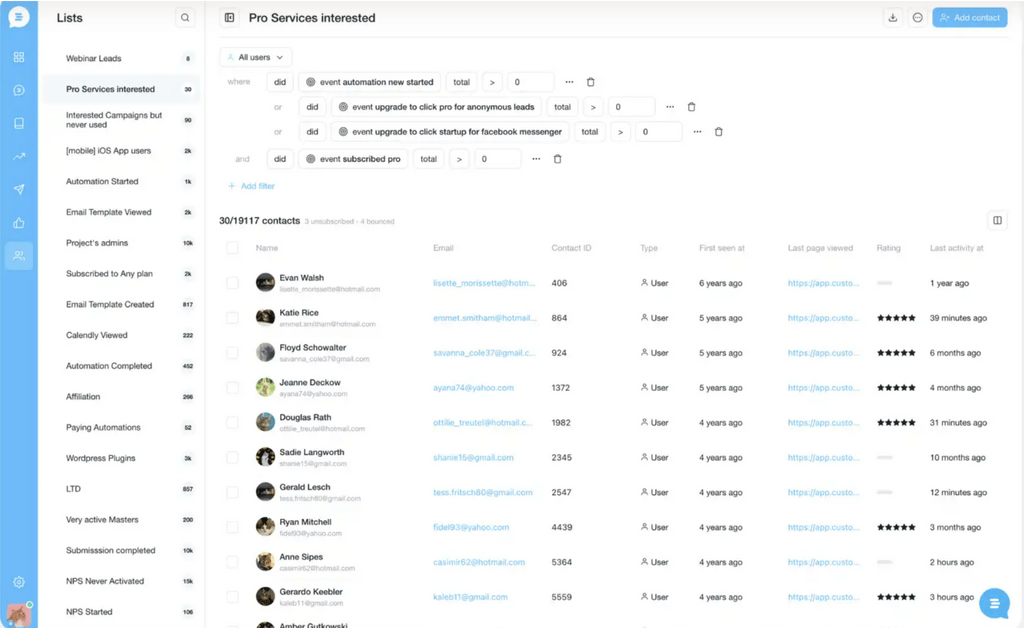
Customerly’s advanced filters allow users to create highly-targeted customer segments. By using your intent data to segment your audience and personalize your marketing efforts, you’re more likely to show them the most appropriate content to qualify them as marketing leads.
Nurture Leads
Marketing automation tools allow companies to nurture their leads and guide them through the sales funnel. With automation software like Customerly, you can build detailed custom sales funnels.
With these, you can, for example, automatically send emails to your audience once they’ve met specific conditions. For instance, when someone signs up for a demo, your software will automatically send welcome emails to them to ensure they know how to use it.
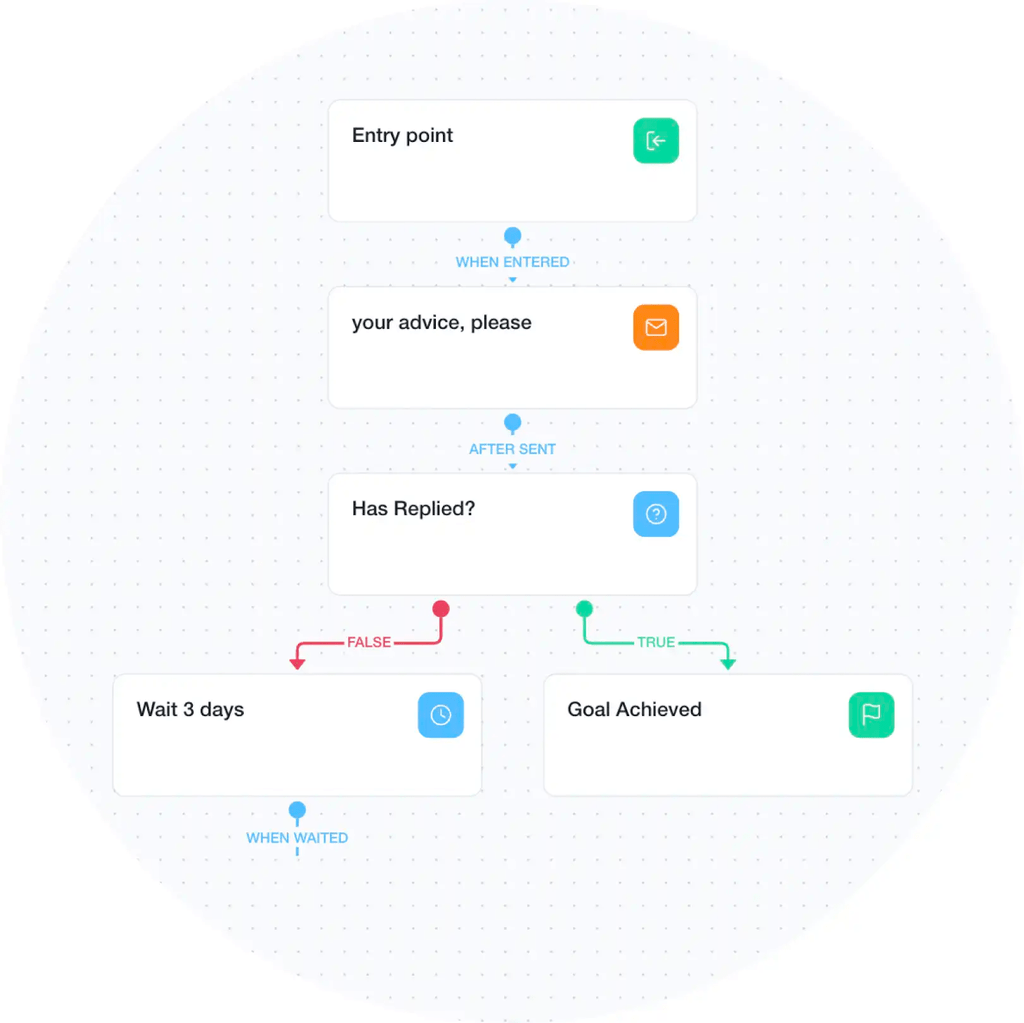
The CEO at Feed Donkey makes use of Customerly’s automated sales funnels, noting the impact of chat triggers in particular “Since implementing chat triggers on our pricing page resources, we have observed visit to conversion rates increase by at least 30%.” Triggering a chat at just the right time nurtures your leads and helps to generate MQLs.
Know When to Disqualify Leads
Knowing exactly when to disqualify leads can be tricky. It can also be difficult to admit that a lead will not be interested in your product, no matter how hard you try. Regardless of these difficulties, disqualifying leads at the appropriate time can save you money and time on your marketing efforts.
There are a couple of sure-fire ways to recognize a lead that shouldn’t qualify as a marketing lead:
- They don’t match your target customer: We realize this sounds counter-productive. However, if the lead doesn’t match your target customer, they’re less likely to buy from you. Disqualifying such leads early on will help you focus your time, money, and resources on marketing to your highest-quality leads.
- Not opening your emails: If you’ve sent emails to an MQL regularly, but they never open them, it might be time to cut them loose and demote them from their MQL status. Keep them on your email lists, though! You never know if an email you send in the future could spark their interest in your brand again!
- Not ready to buy: When someone is a long way from being ready to buy, you might consider disqualifying them as a lead, at least temporarily. If they won’t be in a position to make a purchase for another six months, your marketing efforts in the meantime will be in vain.
- They don’t meet the Budget, Authority, or Need (BAN) criteria: Finally, if your leads don’t meet the BAN criteria mentioned above, you can go ahead and disqualify them.
This list is not exhaustive. You might have a different model to judge whether a lead should be disqualified. The important thing is to know this in advance and to stick by your rules.
Utilize a Lead Scoring System
A lead scoring system provides a clear view of the quality of each lead. It works by awarding points to leads for every action they’ve taken. This could be using the live chat function on your website, downloading a whitepaper, or reading a blog post. You might also award points based on demographics and interests. This point system allows marketers to identify leads that are most likely to make a purchase.
The table below illustrates how your lead scoring system could work. You’ll see that registering for a webinar earns the lead 10 points. Unsubscribing from your email communications, on the other hand, loses them 5 points.
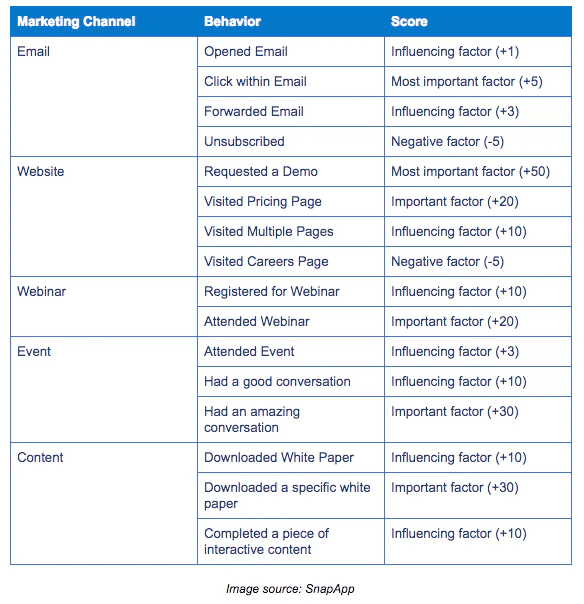
Track trends of Successful Marketing Qualified Leads
Tracking trends and patterns is a marketer’s bread and butter. By tracking trends of successful MQLs, you can try and predict actions and behaviors. This is good for knowing what you, as a marketer, should do and when.
You might, for instance, decipher the average number of times an existing MQL visited your website before signing up for a demo. Therefore, your priority for qualifying existing leads might be to encourage them to visit your website.
Marketing Qualified Leads Best Practices
1. Optimize Your Landing Pages
Your landing pages are super important for attracting MQLs. The average conversion rate of landing pages is just 26%. Therefore, marketers need to ensure their pages are optimized if they’re going to entice further interaction with their brand. Here’s how to do it:
- Simple designs: Don’t clutter your landing pages with tons of information and images. Keep it simple and make use of the white space on the page.
- Be aware of the page fold: Make sure everything important is above the page fold. This way, the visitor knows quickly whether or not the page, and your SaaS product, is useful for them.
- Keep it relevant: Ensure your landing page content accurately reflects the information in your ads, social media posts, or meta descriptions.
- Contrast colors: Use contrasting colors on your landing page to draw attention to the most important parts, such as the signup button.
- A/B test: Did you know that only 17% of marketers utilize the power of A/B testing for their landing pages? This is surprising, considering its huge potential. You can A/B test countless elements of a landing page, like CTAs, product descriptions, and images.
2. Update Your Tactics Regularly
Qualifying leads is an endless task. You need to be consistently reviewing and updating your tactics to weed out the ones that are no longer working in your favor. Something that enticed many MQLs six months ago might no longer have the desired effect.
A good example is if you publish a research report on a relevant topic. It might attract MQLs at first, with interested leads downloading it and becoming marketing-qualified leads. At some point, though, the report will be outdated or covered extensively elsewhere on the net. This will mean it’s no longer as groundbreaking as it once was. Therefore, you might notice a significant dip in downloads.
In this example, your marketing tactic when you published the report would be to promote it widely amongst your leads. However, there would be a point where you need to move on from it and devise new tactics for qualifying your leads.
3. Align Your Content Marketing Strategy With Your Buyer’s Journey
Last but not least, you must ensure you show the correct content to your buyer at the correct stage of their journey. You can do this by understanding what they want to know and when. For example, at the beginning of the journey, you might have blog posts talking about your customer’s pain points. When the lead has shown an interest in your brand by reading that post, you might offer them more detailed information with gated content.
Wrapping Up Our Ultimate Guide to MQLs
We’ve covered a lot of ground today, from why MQLs are important to how to qualify marketing leads. Finally, we’ve gone through a few best practices for qualifying your marketing leads. MQLs remain an essential part of the sales process. Taking the advice offered in this guide on board, you can successfully qualify more leads and amplify your conversions.
If you want automation software that sends the right messages to your customers at the right time, sign up to Customerly today. Our customer service software will help you build meaningful relationships with your SaaS customers to grow your list of MQLs.
